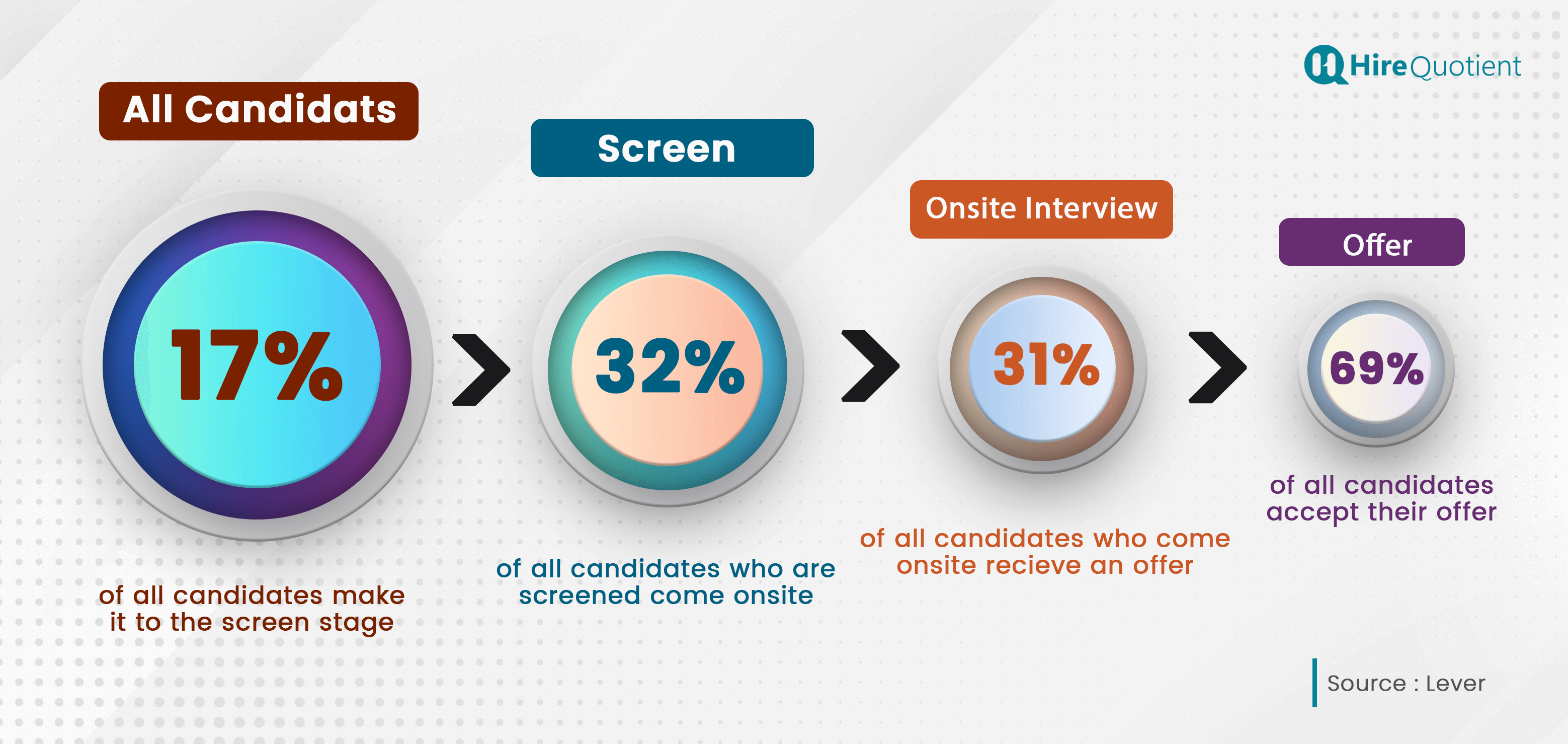The Top 5 Sourcing Metrics Every Recruiter Should Track
Published on April 3rd, 2023
87% of talent acquisition professionals build their talent pipeline through sourcing, according to Entelo’s Recruiting Trends report. That is a big number considering how talent sourcing is becoming the next big thing in the recruitment industry and providing recruiters with a powerful tool to stay ahead of the competition.
With talent sourcing, rather than waiting for candidates to apply to open positions, recruiters can actively seek out the crème de la crème of talent and connect with them directly.
And the benefits of this proactive approach are manifold! By using talent sourcing, recruiters can build a robust pipeline of candidates, ensuring that they always have a pool of top-notch talent to tap into whenever a position opens up.
But hold on just a minute! All your talent sourcing efforts could go to waste if you don't have a way to measure their effectiveness. That's where sourcing metrics come in! These metrics act as your trusty indicators, evaluating the efficacy of your sourcing efforts and ensuring that you're getting the maximum value for your money.
In this blog, we are going to discuss the top candidate sourcing metrics that you should definitely add to your list if you are planning to source candidates for your next big hiring.
1. The Quality of Candidates
What's the point of sourcing candidates if they're not the right fit for the job?
Measuring candidate quality is crucial to ensure that you're attracting top-notch candidates who have the right skills, experience, and personality traits for the job. But how do you measure it?
Well, one way to measure candidate quality is to look at their qualifications and work experience. Are they a good match for the job requirements? Do they have relevant experience in the field? Are their education and training up to par? These are all important factors to consider when evaluating candidate quality.
Another way to measure candidate quality is to look at their soft skills, such as communication, teamwork, problem-solving, and adaptability. Are they a good cultural fit for your organization? Do they have the right attitude and personality traits to thrive in the position?
According to a LinkedIn statistic, 62% of talent teams find more high-quality candidates through sourcing than inbound applications. With such high statistics, it is bound to be true that you can find great quality of candidates by sourcing and hence it becomes a necessity to prioritize this particular sourcing metric.
To measure candidate quality, you can use a variety of tools and techniques, such as skills assessments, behavioral interviews, reference checks, and background checks. These methods can help you evaluate candidates' qualifications, work style, and fit for the position and your organization.
2. The best Sourcing Channel
Naturally, when you begin to source candidates, you do so on multiple platforms such as job boards, social media, job fairs, employee referrals, etc. However not all channels work equally well for all the recruiters and there might be different sourcing channels that work for different organizations.

For example, according to a source 88% of workers say that referrals are the best way to find top-notch candidates. Now you may be a part of this 88% and say that employee referrals has been the best sourcing channel for you, and if not – you can find what channels work best for you and create a new benchmark.
How do I measure the best sourcing channel, you may ask? To find out the best candidate sourcing channel, you should start by analyzing your existing data. Look at your recruitment analytics and see where your top-performing candidates are coming from. Are they sourced through job boards, employee referrals, social media, or other channels? This will give you an indication of which channels are working best for your organization.
To put it in numbers, count the number of candidates you have hired from a particular channel and divide it by the number of total candidates sourced from the channel and multiply it by 100 to find out the percentage, and voila, you have the metrics of the best sourcing channels.
3. Time to Hire
SHRM reports that it takes an average of 36 days to hire a candidate. And that number is just an average of much bigger numbers. Imagine this – you have an urgent hiring requirement but you do not have a readymade candidate pipeline and it takes you 36 (or more) days to hire the candidate. The losses that your organization will bear is going to be unforgivable.
However, if you use our magical talent sourcing tool, EasySource, you can find a bunch of relevant candidates in no matter of time and reduce your time to hire significantly.
But how do you measure if the tool has really slashed your time to hire? How do you make sure that the slashed time to hire success is repeatable in further hiring projects?
To put it in numbers, count the number of days it takes to convert the candidate from being first contacted to hired and check this consistently for every hiring project to get an idea of how this sourcing metric is improving your candidate sourcing efforts.
4. Candidate-conversion Rate
Candidate conversion rate is a powerful sourcing metric that every recruiter should track. It measures the effectiveness of your recruiting efforts in converting potential candidates into actual hires. By monitoring this metric, recruiters can identify areas of improvement in their recruitment processes and increase their chances of success.
Simply put, to calculate candidate conversion rate, divide the number of candidates who were hired by the total number of candidates who were sourced. For example, if a recruiter sourced 100 candidates and hired 10 of them, the candidate conversion rate would be 10%.
According to Lever’s report on startups and small to mid segment businesses, the candidate conversion rate funnel looks something like this:
- 17% – Candidate to screening conversion rate
- 32% – Screening to interview conversion rate
- 31% – Interview to offer conversion rate
- 69% – Offer acceptance rate
- 1.2% – Candidate to hired conversion rate

A high candidate conversion rate indicates that your recruitment efforts are effectively attracting and engaging top talent, while a low conversion rate may suggest that your approach needs refinement. By tracking this metric over time, recruiters can measure the success of their recruitment strategies and make data-driven decisions to optimize their processes.
A note to keep in mind is that the highs and lows of conversion rates depend on the organization, while a 2% candidate conversion rate may be high for a particular industry, it could be low for another one.
Moreover, candidate conversion rate is not just a useful metric for individual recruiters, but it can also provide valuable insights for the organization as a whole. By analyzing conversion rates across different departments or job categories, companies can identify which areas are experiencing hiring challenges and adjust their recruitment strategies accordingly.
5. Cost to Hire
Cost to hire is probably one of the most common sourcing metrics that every recruiter wants to track. It measures the total expenses incurred during the recruitment process for a particular position, including advertising costs, sourcing costs, candidate expenses, and recruiting team salaries. By keeping a close eye on this metric, recruiters can identify areas where they can reduce costs and optimize their hiring process.
To calculate the cost to hire, you need to add up all the expenses incurred during the recruitment process for a specific position and divide it by the total number of hires for that position. For example, if you spent $10,000 on advertising, candidate expenses, and recruiting team salaries, and hired 2 candidates, the cost to hire for that position would be $5,000.
An optimal cost per hire benchmark falls within the range of $3,000 to $5,000. And according to SHRM the average cost per hire is nearly $4,700 which is totally doable for a small to mid-segment business.
Why Is The Cost To Hire An Important Metric?
Tracking the cost to hire is crucial for several reasons. Firstly, it can help recruiters identify where they are spending the most money during the recruitment process and adjust their strategy accordingly. For example, if advertising costs are too high, recruiters can explore alternative channels or adjust their messaging to reduce costs.
Secondly, cost to hire can help organizations plan and allocate resources more effectively. By analyzing the cost to hire across different departments or positions, recruiters can identify areas where they need to allocate more or fewer resources and plan their hiring budgets accordingly.
Finally, cost to hire is an essential metric for measuring the overall effectiveness of the recruitment process. If the cost to hire is too high, it may indicate that the recruitment process is taking too long, or that there are inefficiencies that need to be addressed.
How Can You Improve Your Cost To Hire Sourcing Metric?
Well for starters, you could leverage our talent sourcing tool, EasySource to source a bunch of relevant candidates in just a few clicks. But how can candidate sourcing reduce your cost to hire?
Think about this, when you try to source candidates via the traditional method, viz., job postings, resume parsing and resume screening, you spend a ton of time, resources and not to forget money. However, if you decide to cut on these tasks and use the candidate sourcing tool, you can save a lot of bucks and a lot of time on new hires.
There are several other ways and methods on how you improve your sourcing metrics, but let’s talk about it some other day in detail, till then try to work on the above-listed metrics and witness a ravishing change in your sourcing efforts.
Also Read:
Authors

Radhika Sarraf
Radhika Sarraf is a content specialist and a woman of many passions who currently works at HireQuotient, a leading recruitment SaaS company. She is a versatile writer with experience in creating compelling articles, blogs, social media posts, and marketing collaterals.

Hire the best without stress
Ask us how
Never Miss The Updates
We cover all recruitment, talent analytics, L&D, DEI, pre-employment, candidate screening, and hiring tools. Join our force & subscribe now!
Stay On Top Of Everything In HR
